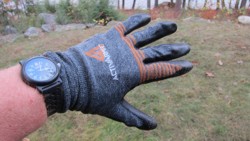Great Gloves for Work
DEAR TIM: I just graduated from college and am pretty wet behind the ears. I've never purchased work gloves before and am thoroughly confused by all the choices. What's your advice on getting gloves that will last and protect my hands. I just purchased a house that needs lots of work and can't afford to injure myself. Scott G., Somerset, NJ
DEAR SCOTT: I can clearly remember years ago when I was your age. If my memory serves me right, there were probably three to five types of work gloves made specifically for the residential construction worker. Now there are scores of highly specialized work gloves made for do-it-yourselfers and the residential construction trades.
Because construction and building is my vocation, when I see all the different work gloves I can purchase, I feel like a child in a huge candy store. The fabrics, design, features and quality of the work gloves today is simply astounding. There's a glove for just about every task, and that's a good thing.

This comfortable work glove has a very flexible and thin waterproof coating on the underside of the glove. Photo Credit: Tim Carter
What you'll quickly discover as you start to do different tasks is that no one glove offers all you need. That was the problem back when I was your age. I could get heavy gloves that protected my hands when I was doing heavy work, but grit got down into the gloves through the open cuffs. You couldn't easily find a work glove years ago that kept your hands dry.
When I needed dexterity to handle small tools or parts, the old gloves available to me offered little warmth or protection. There simply was no silver bullet when it came to work gloves.
But now we're blessed with gloves made from newer synthetic fabrics that are breathable, stretchable and most importantly comfortable. You want a work glove to have a fit and feel such that you don't realize you're wearing gloves. That's always been what I looked for when I was on my quest for the perfect pair of work gloves.
A few days ago, I wore a new pair of work gloves that really impressed me. These light-duty work gloves were made primarily from nylon. This fabric, as any woman will tell you, can be very durable, breathable and comfortable. As you might imagine, nylon fiber can be spun to different thicknesses and it can be woven in such a way as to create fabrics with different thicknesses and smoothness.
The palm side of the gloves I wore were coated with a special nitrile foam. The best way to describe this is a very thin rubberized coating. The coating wrapped up over the finger and thumb-tips as well as the sides of the fingers.
This coating is waterproof but offers incredible dexterity. The ultimate dexterity test for me is my handheld ham radio. If I'm able to push the small buttons on the radio without fat fingering them, then the gloves pass my dexterity test.
It's important to match the glove to the task. For example, if you feel that you'll be handling hot materials or even burning wood that could still be smoldering, I might suggest traditional leather gloves. The last thing you want to wear around a fire, in my opinion, are gloves made with synthetic fabrics that can easily melt and cause severe burns.
Leather is tough and can withstand embers you'll encounter around fires. Firefighters wear special gloves made for this purpose. Stop by a firehouse, ask the shift commander to show you the gloves he wears. You can bet that gloves worn by firefighters are tough, waterproof and offer superior protection.
If you're going to be working around sharp metal, look for gloves that offer superior protection from cuts. Newer fabrics exist that actually are very resistant to slices caused by sharp metal and knives. Years ago, I tested a glove at a convention that you could actually score with a new razor blade and the blade would not cut through to my hand. It freaked me out testing it.
I distinctly remember in the past taking a new pair of brown cotton work gloves and cutting off the fingertips so I could handle nails in the winter time. Some of these gloves were coated with rubber dots to increase gripping power.
You can now purchase construction work gloves that allow you to hold and position nails, but your fingertips are not exposed to the weather. You're so lucky to have gloves like this.
You can watch a video that shows new different work gloves. Simply click on this link "work gloves video".
Column 960
